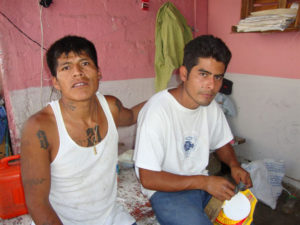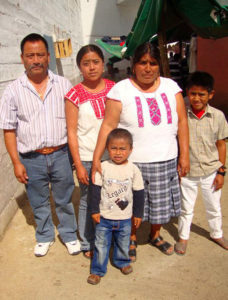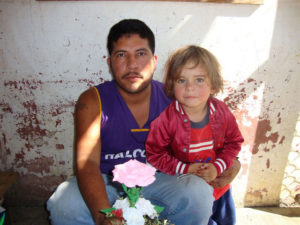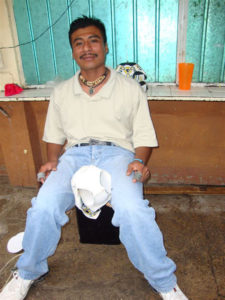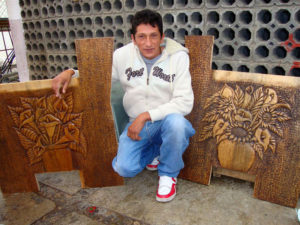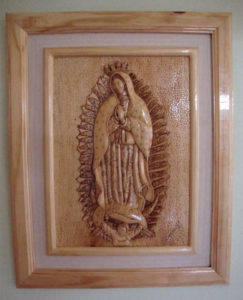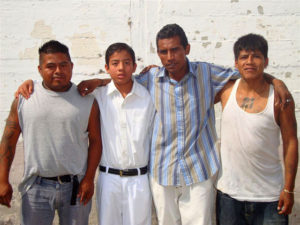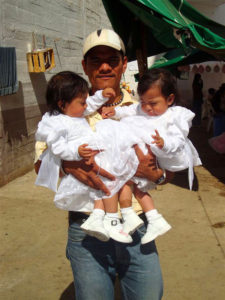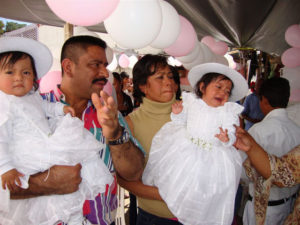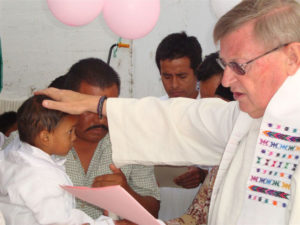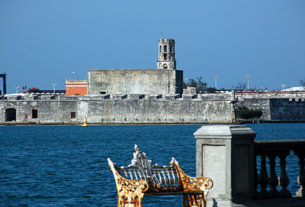At 9:15 a.m. on February 3, 2010, I steeled myself to enter the Central Penitentiary in Oaxaca, Mexico. Having heard stories of overcrowding, rampant drug use, filthy conditions, torture, inadequate food, poor health care, disease and corruption, my personal concern about entering such a place was great. Fortunately, I was not here as a prisoner but as a guest of the Reverend Spencer Thompson, padre to the inmates. At his invitation, I would observe prison conditions and his ministry in action. This is a recounting of my experiences.
At the main gate, heavily armed guards in full military dress searched Thompson’s ten year old vehicle for contraband. Before entering the main prison compound, we passed two checkpoints where all possessions were examined, photo identification was produced and taken and we were physically searched. After a second identification check, we were allowed to proceed “at will” and unescorted.
Once inside the prison walls, we entered a short tunnel that exited onto an enormous outdoor compound where twenty or so young men were playing soccer on a concrete field. We were now in the main prison compound. Within seconds, we were surrounded by six young men eager to shake the reverend’s hand and give him a hug. This same scene would unfold as we circumnavigated one wing of this prison of 1,200 inmates over the course of three hours.

Right from the start, I was confused by what was going on. I expected a highly regimented environment. What I saw was more like a schoolyard. There were women and children coming and going everywhere. Third, the soccer field was surrounded by kiosks selling food and other staples. It actually had the aspect of a county fairground. The people we encountered were dressed in street clothes, albeit in varying degrees of shabbiness. There were no prison uniforms and Rev. Thompson explained to me that they were in fact the prisoners or their family members. Most of prisoners were young. As our tour progressed I learned a great deal about the Mexican prison system: some aspects of which were very admirable and some much less so.
It was my intent to write a human interest story on the mission of Thompson. However having met and hugged many prisoners, having talked to them at length and having listened to their concerns, the story has evolved into one of the human condition and the interaction between the guards, the prisoners, the prison administration and Thompson. To me, the prison, and my experiences of it, brought forth feelings of delight and pathos blended in equal dollops.
The Prison
Permit me to give you a sense of our environment — not as a moving revelation but as a recollection of the facility over a number of days. This is a penitentiary and it is constructed of concrete and steel. Picture a large box with high concrete sides enclosing a central compound surrounded by various rooms, dormitories, workshops and prison cells.
The majority of prisoners are housed in windowless, concrete dorms of about 50 x 20 feet.
The prison authority provides no blankets, no beds, and no mattresses: nothing. The prisoner is escorted to the dorm and told this is your new home. When you sleep, you pull up a corner of the concrete floor. Over time and with the help of family, the prisoners have constructed their own little rooms made of a wood frames to which are attached blankets granting some semblance of privacy. The stalls are about 4 x 6 feet, some of which are furnished with beds, cooking equipment, shelving for clothing and one even had a TV although I have no idea how the electrical system was accessed.
Special prisoners, mainly drug users, are housed in cells with metal bar doors. About six to nine prisoners are housed to a cell equipped with bunk beds three levels high. The beds are poured-in-place concrete and that is the totality of the furnishings supplied by the state. Once again the prisoners must provide, through whatever means, their bedding.
Throughout the day, these special prisoners have complete access to the rest of the prison although they do have their own work zone and are locked in after 8 p.m.
You circumnavigate the prison wing along the perimeter walls where a walkway about 40 feet wide separates the dormitories from the wall. Near the far end of the wing is a section for women prisoners, of which there are about 120. The women have a small exercise area fenced off in the front of their dormitory. Men can walk through this area with impunity but access to the women’s dorm is restricted by guards. At the extreme end of the wing is an infirmary which provides minimal medical attention.
Throughout the day, you will find most men and women engaged in some form of work. The prison is a hot bed of entrepreneurship. The prisoners are engaged in various activities to make money to pay for basic necessities like food and clothing. The most common form of work is hand sewing of soccer balls. This is a state run enterprise and the prisoners are paid 8 pesos — or roughly 75 cents — per finished ball. Other businesses include wood carving, the manufacturing of roses out of bars of soap, manufacturing of simple jewelry, basket weaving, the running of small restaurants, sewing of clothing and manufacturing of metal trinkets, hammocks, picture frames and other specialty crafts. These wares are sold to visitors or carried out of the prison by family to be sold in the open market. Some of the more talented prisoners take orders for their goods from outside merchants.
Within the walls, the prison is completely open. Almost nobody is locked in cages. The prisoners and visitors are free to move about at will. Many prisoners have their families with them throughout the day, including broods of children often conceived within the prison walls. Wives are often working with their husbands making goods for sale. There is great camaraderie amongst the prisoners and the visitors, and everyone keeps an eye on the children. Some fathers provide day care while the mother works in the city of Oaxaca.
The Inmates
When tourists or visitors are asked what they like most about Mexico, they will usually say it is the people. Mexicans are known for their friendliness, warmth and curiosity, for the ability to enjoy life and be happy no matter the circumstances, for their helpfulness, for their courtesy and for their love of children.
Extraordinarily, these same national characteristics are prevalent within the prison walls. All the prisoners I met — and that was at least 150 — greeted me with a warm smile, a hearty handshake and an embarrassing hug. There were no long faces, no sullenness and no poor-me attitudes. Some men lamented their bad decisions in life but never blamed others or asked for a break. They accepted their fate and were making the best of it. I met with extreme courtesy at all times and I saw first-hand the love and devotion parents had for their children as well as the love and respect children had for their mothers and fathers no matter their parents were prisoners.
By contrast, if you asked certain prisoners if you could take their photo, they would revert to their gang mentality showing off their tattoos and gang signs.
There are two distinct economic classes amongst the prisoners. There are the “haves” and the “have nots.” It is plainly visible in their dress. The “haves” are reasonably well dressed with decent shoes while the “have nots” wear ratty jeans and shirts with the meanest footwear one can imagine.
The distinction is entirely dependent on the availability of relatives in the immediate vicinity of the prison. If family is nearby, the inmate can rely on the delivery of clothing and bedding as well as medicine and supplemental food. Family can also remove handicrafts from the prison and sell them in Oaxaca. If there is no family nearby, the inmate suffers economic and emotional deprivation.
Physically, the prisoners appear relatively healthy, at least to my unstudied eye. They are mostly young and therefore still physically strong in spite of very insufficient medical attention. Minor injuries in the prison are not uncommon. One young chap showed me a foot injury suffered that day by stepping on a nail. The wound was cleaned at the infirmary and the man was given a tetanus shot but the wound was not dressed and a big flap of skin hung loose. Now, whenever we go to the prison, we take along a dozen or so bandages to deal with matters like this. We also encountered several prisoners with vision problems which is a definite handicap when stitching soccer balls. There is no eye care in the prison. Dental care doesn’t exist and that is readily evident in the condition of the teeth of many prisoners.
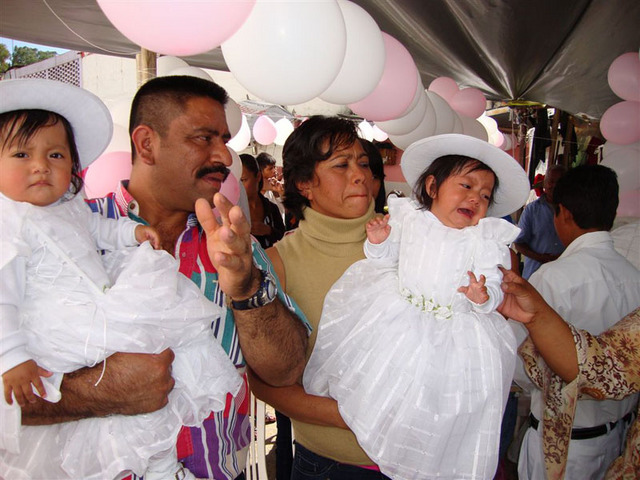
There is a common misconception that the prisoners are not fed by the state. This is not true. They receive two meals a day, although the diet does not vary. At breakfast, each prisoner receives a large bowl of rice with vegetables and a stack of tortillas. In the mid afternoon, they get some sweetbreads. Those with money can also go to various canteens run by the inmates to supplement their diet. You won’t find any fat people in the prison but nobody seems to be starving either.
One cannot help but be impressed by the industriousness of most inmates. If they are to enjoy any supplements to their meager existence, they need to make money and so they sit hour after hour at their chosen profession. After many years, some have become artisans. One man in particular caught my attention. He is in his mid-thirties and as thin as a blade of grass. He is a wood carver and makes elaborate carved church pews, bas relief pieces and even takes commissions from outside the prison. Over the years, with his income, he has purchased an entire workshop including routers, a table saw, sanders and a huge assortment of carving knives. He trains others who are interested. This man has had to rely on his own wits to survive. He has no family in the area and has never had a personal visit during his ten years of imprisonment except for Reverend Thompson. His profession is now his sole means of surviving economically and mentally.
The inmates are also highly adaptive. Although there is a soccer pitch, there are not enough pairs of running shoes to go around, so they share what they have by trading off shoes as they go in and out of play.
Family life continues in the prison unabated. As mentioned, wives, children, girl friends, mothers and fathers all try to maintain the family in spite of the restrictions. Having entire families together daily lends normalcy to everyday life. Conjugal visits are not of the slightest concern to prison authorities. One man introduced me to his five visiting children, some of whom were conceived during his incarceration. His youngest is now three years old and a perfectly delightful little man.
Homosexuality is also prevalent, as is rape of prisoners. In a bizarre practice, the victim of rape is tattooed with a tear drop below the eye by the offending party and his accomplices.
The Mexican justice system is based on Napoleonic law wherein a person is guilty until proven innocent. If you are accused of a crime, you go to jail and wait for a trial.
For many in the Oaxaca state central prison, that trial has yet to occur. It is estimated that 40% of inmates in Mexican prisons have yet to be convicted. For most, their trial is held in absentia and they learn through the prison administration that they have been found guilty and sentenced to a term in the penitentiary. Jail terms in Mexico are quite lengthy and there is seldom abatement of term for good behavior.
The Administration
The prison is run and administered as a branch of the state police. It is headed by a director or warden who is a political appointment of the sitting governor. The current warden has done an excellent job of eradicating drugs from the prison in the past several months and has earned the highest respect from Reverend Thompson. (He has recently been removed from his position.)
The outside perimeter of the prison is protected by heavily armed security forces but the main work goes on inside the walls. The inside guards are dressed in black and no prisoner is allowed to wear that colour. These guards are not armed. They stroll occasionally throughout the prison, interacting with the inmates. They appear to be an affable group of men and women and don’t exhibit any aggressive militaristic behavior. They are simply making sure everything is running smoothly. One guard takes note of my presence wondering who I am and why I am there but the enquiry is more casual than antagonistic.
The principal work with the prisoners is handled by a cadre of social workers. They are primarily women and are young and well educated. They are the record keepers of the prison. They also provide letters of authority, permitting people like Reverend Thompson to visit the prison. They do their utmost to provide social diversion for the prisoners.
A Christmas pageant known as Three Kings Day is organized with the prisoners as actors. Live music and clowns are allowed into the prison to entertain the children and the adults. At Easter, a re-creation of the trial of Jesus and his crucifixion is produced. The prisoners are decked out in period costume including wooden swords and spears. The entire event is filmed and made available as a movie on DVD.
The social workers also facilitated a baptism ceremony officiated over by Thompson. They permitted tents, barbecue equipment and food to be brought into the prison the night before the event. It was also through their efforts that Thompson was granted access to the female prisoners.
The Reverend
The Reverend Spencer Thompson is a graduate of Greensboro College, North Carolina and Boston University School of Theology. He was ordained by the Methodist Church shortly after graduation.
He never served a local church.
For forty years he was a child welfare administrator with a focus on community based services and adoption programs in the states of Massachusetts and New York. He is a man of great compassion and brought his work home with him by adopting eleven children to complement his three natural offspring. Five years ago, after retiring, he moved to Oaxaca intent on opening a bed and breakfast to supplement a very limited pension and to enjoy the lower cost of living in Southern Mexico.
He never did open a B&B but rather assisted an Anglican priest from Texas who wanted to bring the sacrament and the word of God to the prisoners. Three years ago Thompson took over the task. He is now a United Methodist minister working under the auspices of the Anglican Church of Mexico bringing pastoral care to Roman Catholics. The ambiguity of his current situation is not lost on him.
Depending on your perspective, Thompson’s main failing or virtue is his inability to see a limit to compassion. His role in the prison has expanded well beyond delivering the word of God to full blown pastoral care and he has become a one man welfare agency. Each Wednesday and Thursday visit to the prisoners is also the opportunity to bring the prisoners much needed supplies like soap, toothpaste, toothbrushes, shampoo and used clothing and shoes. On Thursdays, he brings a bag of 100 oranges to hand out. The prisoners seldom ever see fruit.
The Oaxaca Lending Library acts as a repository for used clothing and old Spanish language magazines and books. It is quite remarkable to see young men eagerly receive a twenty year old magazine and then scurry off to some corner of the prison to sit and read.
It doesn’t take long to realize the high regard of the inmates for the Reverend. Groups of prisoners surround him as he wends his way through the prison. They greet him with great affection and he speaks to each one, asking about their families, their health and their needs. Some follow him throughout his rounds and some are eager to return to their work. He knows all of the children by name. The children always ask for pesos and he invariably offers besos (kisses) to which they reply “no-no-no, pesos”.
Many prisoners come to him with specific and urgent needs such as the use of a telephone card to call home since a parent or a child has died. Others need medicine which he can’t supply. Others need vitamins. One man needs an artificial leg which is well beyond his means but he has enlisted the support of an American doctor to evaluate the man’s condition through photos and measurements provided by Thompson.
Baptisms are now a part of Thompson’s routine. The children come to the prison dressed up in elaborate finery and a beautiful ceremony, sponsored by the Godparents, follows. How many children in this world have been baptized in a state penitentiary?
Recently, Spencer has taken on pastoral care for the drug abuse unit. This has added a further 42 prisoners to his flock. They meet in a tight room and are an incredibly enthusiastic group. There is strict drug enforcement in the prison now and these men are adjusting well. They are very attentive and devout during the religious and communion services held prior to meeting one on one with their pastor.
For the most part, Thompson funds his mission out of his own pocket. This includes the costs of a translator. The reverend is very well known in Oaxaca, and occasionally, other expatriates give him some financial support. It has taken him three years to build a rapport with the prison administration and the prison body, and he must be extraordinarily careful not to upset entrenched interests. He is allowed into the prison solely at the discretion of the prison administration. He understands all too well that his role is as a pastor to the prisoners and not a critic of the prison. He dances a fine line as an advocate for each prisoner in his flock. Many visitors to Oaxaca take a profound interest in his work owing to some background in health care or social work and insist on accompanying him to the prison to set things right. With great tact, he tries to deflect these noble gestures lest the entire mission is put at risk.
In our discussion, Thompson tells me that he funds his work with the prisoners for about $250 per month plus donations of clothing and books. He could do much more with some help but that is all he is capable of doing from his own resources. It is beyond amazing what he is able to accomplish with such a small amount. He shops very carefully.
Oranges are purchased at $5 per 100. One hundred toothbrushes, tubes of toothpaste and razors were donated. With a donation of $130 he outfitted a complete basketball team of 12 players with shorts and shirts complete with names and numbers. These uniforms are a source of immense pride to the prisoners. He varies the gifts he brings the prisoners weekly. Sometimes it is soap, sometimes it is shampoo. The prisoners desperately need other things like shoes, warm clothing, blankets, eyeglasses, vitamins and medicine which are all beyond his means.
It is hoped that this article — through wide circulation — might generate some donations to his cause, but he is well aware that prisoners may not be a high priority for donors given the broader social needs in Mexico. This begs the question as to why he has chosen to work with prisoners with the inherent risks of disease and violence and why people should support him in his efforts.
“Never once in my life did I imagine visiting a Mexican prison much less twice a week, on purpose, for years. Though I had planned to build a bed and breakfast in Oaxaca Mexico, I now believe I was actually sent here to deliver and enjoy this extraordinary ministry to the prisoners and to the prison staff. I have no illusions about the people I am ministering to. Many have done some terrible things, but in the eyes of God their sins are forgivable. I don’t judge them; I just try to do the best I can to make their lives better. I think my work does me as much good as it does the prisoners. I have never been happier in my life.”
Aren’t you worried about your safety or your health?
“I have never been afraid in the prison. I have had a great life and I am ready for whatever hand I am dealt. There have been occasions where I have met with prisoners who, unknown to me, had some serious disease like TB but I have yet to catch a cold in my three years of giving pastoral care. I can also tell you I have never seen any violent behavior amongst the prisoners. There was a brief fight between two soccer players on the same team when one missed a very easy goal. However, they made up quickly and resumed the game.”
Your predecessor provided a religious service to the prisoners. You have expanded this to include considerable pastoral care as well as a religious service. Is one more important to you than the other?
“Pastoral care now takes up most of my time. This is when I have a chance to meet with inmates one on one, to get to know them personally and get to help them as best I can. Sometimes they just need guidance on a personal matter, but most often they need human interaction if they have no relatives or they need real help to deal with physical or emotional health. I also strongly believe in the need to spread the message of health, healing, wholeness and newness of life which is the Gospel of Redemption. I think both aspects of my ministry are equally important. My predecessor had far greater responsibilities throughout Mexico and was unable to provide this type of pastoral care.”
What is your relationship with the prison administration?
“Right now, I think it is pretty good. Recently one of the guards came to me and said I was doing a great job. However I really have to be careful not to overstep the boundaries set for me. I keep a close relationship with the social workers on the prison staff and try to be an advocate for certain inmates in need of special help. To some extent that is also their job, so I can’t be pushy or I may get kicked out. That would break my heart. Other ministers and priests come to the prison occasionally and take a stab at what I am doing but for the most part, they stop coming after a month or two. I think the administration now sees that I am here for the long term and am truly dedicated. I am almost as much a fixture here as the prisoners but I try never to get carried away. I just nibble away at the corners and each little victory is a big accomplishment for me.”
You are a very religious man.
“Well, I have been an ordained minister for over forty years so that shouldn’t surprise you. I try not to be in your face about it but I do have a real passion about my work at the prison. After all, I never had a local church before so this is my first. When I think about the prisoners, I remember an old Methodist hymn that says: ‘For His angels here are human not the shining host above, and the drumbeats of His army are the heartbeats of our love.’ Even if one is not religious at all, one can find understanding in that line.”
Conclusion
I have tried to convey to you the reality of the prison system in Mexico as well as the work of one dedicated man to make that system more humane. Whatever we might think about prisoners or criminals, we cannot deny that they are still human beings worthy of our consideration and compassion. If you believe in the work of Reverend Spencer Thompson, please support his work both financially and materially. If you live in Oaxaca or are just visiting, please bring surplus clothing, eye glasses, blankets, shoes, medical supplies or the like to the Oaxaca Lending Library. These items are of immense benefit to the inmates.
If you live in the U.S. or Canada, think about making a small financial contribution. It is almost impossible to send anything by mail in Mexico, so tax-exempt charitable donations can be made to the following organizations:
Trinity United Methodist Church
PO Box 38
Grand Island NY 14072
Or
The Peace and Justice Center; Oaxaca Account
P.O. Box 16252
Phoenix, Arizona 85011
Be sure that all donations are clearly marked “Oaxaca Prison Ministry of Spencer Thompson. Please send an email to Spencer letting him know of your kindness.


